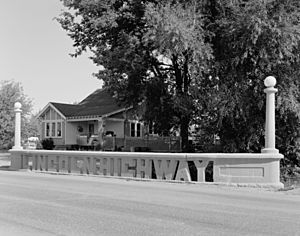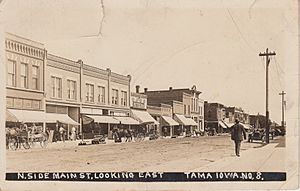Tama, Iowa facts for kids
Quick facts for kids
Tama, Iowa
|
|
|---|---|

Tama, Iowa
|
|

Location of Tama, Iowa
|
|
| Country | |
| State | |
| County | Tama |
| Area | |
| • Total | 3.12 sq mi (8.07 km2) |
| • Land | 2.97 sq mi (7.70 km2) |
| • Water | 0.15 sq mi (0.38 km2) |
| Elevation | 840 ft (256 m) |
| Population
(2020)
|
|
| • Total | 3,130 |
| • Density | 1,053.52/sq mi (406.74/km2) |
| Time zone | UTC-6 (Central (CST)) |
| • Summer (DST) | UTC-5 (CDT) |
| ZIP code |
52339
|
| Area code(s) | 641 |
| FIPS code | 19-77115 |
| GNIS feature ID | 0462174 |
Tama is a city located in Tama County, Iowa, in the United States. In 2020, about 3,130 people lived there.
Tama is very close to Toledo, which is the main town of the county. The two cities are so close that they almost look like one big town.
Contents
History of Tama
Tama started in 1862. This was after the Cedar Rapids and Missouri River Railroad built its tracks through the area. The railroad helped the town grow.
Tama is also near the Meskwaki Settlement. This is the only important Native American community in Iowa. The city was built along the famous Lincoln Highway. This was one of the first roads that went all the way across the United States. You can still see an original Lincoln Highway bridge in Tama. It is even listed in the National Register of Historic Places because it is so important. The city of Tama is named after Taimah, a leader of the Meskwaki people in the 1800s.
Geography of Tama

Tama covers a total area of about 3.41 square miles (8.83 square kilometers). Most of this area is land, about 3.26 square miles (8.44 square kilometers). A small part, about 0.15 square miles (0.39 square kilometers), is water.
Population and People in Tama
| Historical populations | ||
|---|---|---|
| Year | Pop. | ±% |
| 1870 | 1,161 | — |
| 1880 | 1,289 | +11.0% |
| 1890 | 1,741 | +35.1% |
| 1900 | 2,649 | +52.2% |
| 1910 | 2,290 | −13.6% |
| 1920 | 2,601 | +13.6% |
| 1930 | 2,626 | +1.0% |
| 1940 | 2,832 | +7.8% |
| 1950 | 2,930 | +3.5% |
| 1960 | 2,925 | −0.2% |
| 1970 | 3,000 | +2.6% |
| 1980 | 2,968 | −1.1% |
| 1990 | 2,697 | −9.1% |
| 2000 | 2,731 | +1.3% |
| 2010 | 2,877 | +5.3% |
| 2020 | 3,130 | +8.8% |
| Source: and Iowa Data Center Source: |
||
In 2020, there were 3,130 people living in Tama. The city had about 1,118 households.
Many different groups of people live in Tama. About 64% of the people were White. About 7% were Native American, and about 1.5% were Black. About 14% were from other races, and about 13% were from two or more races. A large part of the population, about 31%, was Hispanic or Latino.
The average age of people in Tama was about 35 years old.
- About 30% of residents were under 20 years old.
- About 26% were between 25 and 44 years old.
- About 16% were 65 years old or older.
The city has slightly more females than males.
Healthcare Services
People living in Tama and Toledo can get healthcare at MercyCare Tama or Unity Point Toledo Clinic. If someone needs to go to a hospital, the closest ones are Grinnell Regional Medical Center or UnityPoint Health - Marshalltown Hospital.
Education in Tama
Students in Tama attend schools that are part of the South Tama County Community School District.
Notable People from Tama
Many interesting people have come from Tama, including:
- Vivia Belle Appleton - A doctor and medical missionary.
- Paul Bradley - A retired mixed martial arts (MMA) fighter.
- Lance Horbach - A person who served in the Iowa House of Representatives.
- Andre Roberts - Another retired MMA fighter.
- Bob Soth - A long-distance runner who competed in the 1960 Summer Olympics.
- Ska-ba-quay Tesson - A talented Meskwaki artist.
- Lewis Haines Wentz - A successful businessman.
See also
 In Spanish: Tama (Iowa) para niños
In Spanish: Tama (Iowa) para niños


